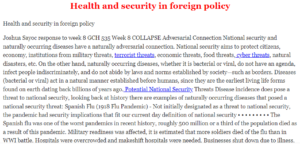Health and security in foreign policy
Health and security in foreign policy
Health and security in foreign policy
Joshua Sayoc response to week 8 GCH 535 Week 8 COLLAPSE Adversarial Connection National security and naturally occurring diseases have a naturally adversarial connection. National security aims to protect citizens, economy, institutions from military threats, terrorist threats, economic threats, food threats, cyber threats, natural disasters, etc. On the other hand, naturally occurring diseases, whether it is bacterial or viral, do not have an agenda, infect people indiscriminately, and do not abide by laws and norms established by society—such as borders.
Diseases (bacterial or viral) act in a natural manner established before humans, since they are the earliest living life forms found on earth dating back billions of years ago. Potential National Security Threats Disease incidence does pose a threat to national security, looking back at history there are examples of naturally occurring diseases that posed a national security threat: Spanish Flu (1918 Flu Pandemic) – Not initially designated as a threat to national security, the pandemic had security implications that fit our current day definition of national security • • • • • • • • • The Spanish flu was one of the worst pandemics in recent history, roughly 500 million or a third of the population died as a result of this pandemic. Military readiness was affected, it is estimated that more soldiers died of the flu than in WWI battle. Hospitals were overcrowded and makeshift hospitals were needed. Businesses shut down due to illness. Lack of available works slowed economic activity. State and local health departments shutdown (History.com Editors, 2010). Ebola (2014-2016) – The 2014 Ebola outbreak posed a national security threat and had every country on high alert and worried about individuals who traveled to and from West Africa. In terms of security in West African countries, the 2014 outbreak of Ebola put huge stresses on underprepared health care infrastructure in Liberia. o Studies showed that several hospitals in Liberia lacked the essential medical supplies, such as gloves, depleted supplies of soap and cleaning supplies, and poor communication capabilities (Forrester et al., 2014). The international health community responded in west Africa by providing aid in the forms of health workers and supplies o Incidentally this led to a few Ebola cases being treated in Spain, Italy, and the United States, mainly among health care workers who recently traveled to west Africa (Center for Disease Control and Prevention, n.d.). During the 2014 outbreak, then Presidential Candidates Chris Christie and Donald Trump promoted the idea of travel bans for countries affected by Ebola. o Evidence shows that travel bans do not work, since determined individuals will get into a country no matter what, and that travel bans weaken our disease and surveillance capabilities (Belluz & Hoffman, 2019). Belluz, J., & Hoffman, S. (2019, July). Ebola outbreak 2019: Closing borders to stop the disease won’t work. Retrieved October 16, 2019, from https://www.vox.com/2014/10/18/6994413/research-travel-bans-ebola-virusoutbreak Center for Disease Control and Prevention. (n.d.). Global Health Security | Division of Global Health Protection | Global Health | CDC. Retrieved October 16, 2019, from https://www.cdc.gov/globalhealth/healthprotection/ghs/index.html Forrester, J. D., Pillai, S. K., Beer, K. D., Bjork, A., Neatherlin, J., Massaquoi, M., … Cock, K. D. (2014). Assessment of Ebola Virus Disease, Health Care Infrastructure, and Preparedness—Four Counties, Southeastern Liberia, August 2014. 63(40), 3. History.com Editors. (2010, October). Spanish Flu. Retrieved October 16, 2019, from https://www.history.com/topics/world-war-i/1918-flu-pandemic Yashvi Aware Week 8 COLLAPSE Disease and Security Naturally occurring diseases and national security are very related, as an infectious disease outbreak has the potential to destabilize a nation and cause tremendous economic and social harm.The threat of disease can result in social instability, especially when a nation or community has never experienced a specific outbreak before, or is not prepared. Monetary resources, health care professionals, and facilities are strained during such instances, which can further propagate unrest (Cecchine and Moore). Those looking to harm a nation could prey upon these vulnerabilities to create greater harm, and bioterrorism could even cause the initial outbreak and trigger catastrophe. Disease Incidents In 2016, President Obama sent the U.S. military into Liberia to help assist with the containment of Ebola because he recognized the threat it had to not only Liberia or Africa, but across the Atlantic Ocean into the U.S. (Gostin and Hodge, 2016). If any of those soldiers were infected, many of our service members could be lost as well. Loss of service members poses a clear threat to our national security. Another disease of interest is HIV/AIDS, which has prevalence in military personnel in regions across the world. Because of this, the President’s Emergency Plan for AIDS Relief in 2003 worked to provide global support for prevention and treatment services. (WHO.Int) When diseases are perceived as security threats, they are able to garner more political support and funding that helps people in communities live healthy lives and keep nations safe. Impact of Disease Diseases such as Zika have the ability to directly impact national security by the strain they place in economical and social structures. As hot zones of Zika increase, travel is lessened- which directly impacts our economy. The future of children and mothers infected with Zika are still being studied and we do not know the disease burden complete. This disease impacts an entire generation of people that might not be able to contribute to economic and social growth because of the disease. (Gostin and Hodge, 2016). Zika can also have indirect impacts on factors like contraceptives and family dynamics for those having to care for those affected by Zika or other infectious diseases. References Cecchine, Gary, Moore, & Melinda. (2006, August 2). Infectious Disease and National Security: Strategic Information Needs. Retrieved from https://www.rand.org/pubs/technical_reports/TR405.html. Gostin, L. O., & James G. Hodge, J. (n.d.). Zika Prevention Is a Matter of National Security. Retrieved from https://time.com/4449287/zika-prevention-national-security/. Health and security in foreign policy. (2011, March 4). Retrieved from https://www.who.int/bulletin/volumes/85/3/06-036889/en/. Melissa Gray security threats with disease COLLAPSE Association between naturally occurring diseases and security, deliberating on how and why disease incidents could become national security threats: There is a clear link between diseases and national security. Katz (2019) describes the relationship by categorizing the information into two sections- indirect and direct. Examples of direct links between health and national security include the use of biological weapons or intentional spread of disease as well as when diseases affect our armed forces (Katz, 2019). A nation that is trying to defend itself is less effective if the military is dying from infectious diseases. The overall “readiness” is directly affected by those ill individuals. Examples of indirect links between health and security is the issue of morbidity and mortality. Large loss of life, or large sectors of the population being affected by diseases, can result in economic loss, societal disruption or disorder, fear of disease, unrest, or deterioration of the population (Katz, 2019). A nation that is “safer” from the spread of infectious diseases, meaning that they can respond rapidly to outbreaks or work to prevent outbreaks, is a stronger country in regard to their safer security measures. Especially since people are constantly entering and leaving countries, there is potential for quickly spreading diseases. Diseases can compromise the ability to protect and respond if the population is severely affected or exposed without preparedness plans. In an article by the National Academy of Sciences (NAS) (2003) they referred to the National Intelligence Council 2000 report and mentioned how emerging diseases or biological agents can pose a large threat on global security. They stated that the future of global security with infectious diseases is influenced by the antimicrobial resistance, the research and development of vaccines, developing transitional economies where everyone in the population despite income level can have good quality of life where they are protected from disease, and the effectiveness of surveillance and response in public health infrastructure (NAS, 2003). Two disease that have posed a security threat: Two diseases that have posed a security threat are influenza (H5N1) and HIV/AIDS. They have each caused economic impact from any size outbreak and HIV/AIDS continues to be a threat to public health. Each has led to incorporating political action and funds to create Relief Funds (AIDS Relief) or aid programs to protect both diseased and non-diseased individuals. Increased interest in protecting another outbreak from occurring is the national security threat that public health workers are working to protect (Katz & Singer, 2003). Working to get a larger portion of the population vaccinated from the flu is an example of protecting the public from large outbreaks. Examples of disease incidents that had (or have) security implications: The Zika virus caused security implications in 2015 when it finally made global news. The virus was first discovered in 1947 in Uganda but it was not until 2015 that more attention was brought to it (Katz, 2019). Reports were starting to show significant numbers of virus indication especially when it crossed over into Caribbean, Puerto Rico, and parts of the U.S. (Katz, 2019). Another example includes Ebola in West Africa. It took a year from the outbreak occurring to the time that the WHO declared it a public health emergency. The disease spread rapidly and across national borders which demonstrates the security implications that occurred (Katz, 2019). Consider emerging and re-emerging diseases such as SARS, HIV/AIDS, Ebola, Zika and measles and describe how these diseases can directly and indirectly impact the security of nations: SARS- Indirect- individuals are not travelling due to fear of contracting disease. Does not impact security immediately, but can affect the economic growth. Direct- diseased individuals travelling across countries spreading the disease. HIV/AIDS- Indirect- infected individuals cannot get the job/career they want due to their disease (ex: joining military). Armed forces have to be healthy to protect the nation. Direct- orphans from HIV/AIDS has increased and labor force has shrunk due to sick individuals. Economic unrest is a direct result. Ebola- Indirect- overload of infected individuals are turned away by overcrowded clinics and health care facilities—the number of health care workers to infected individuals is not a realistic ratio. Direct- individuals flee areas and end up in other regions in effort to escape- could still be infected and unaware that they are spreading the disease. Zika- Indirect- infants born with complications, costing healthcare and families more money to maintain or assist. Direct- individuals fear the virus. Infected individuals may spread the disease through sexual contact. Measles- Indirect- vaccinations do exist but fear of travelling before your child is fully vaccinated can be an issue. If you travel and return home after being exposed, the illness could be dormant for a few days before symptoms appear. Direct- highly contagious illness that can spread quickly and cause outbreaks in new regions. References: CDC. (2019). Top 4 Things Parents Need to Know about Measles. Retrieved from https://www.cdc.gov/measles/about/parents-top4.html Katz, R., & Banaski, J. A. (2019). Essentials of public health preparedness and emergency management (2nd ed.). Burlington, MA: Jones & Bartlett Learning. Katz, R. & Singer, D.A. (2007). World Health Organization: Health and security in foreign policy, 85(3). Retrieved from https://www.who.int/bulletin/volumes/85/3/06-036889/en/ National Academy of Sciences (NAS). (2003). Microbial Threats to Health: Emergence, Detection, and Response. Retrieved from https://www.ncbi.nlm.nih.gov/books/NBK221484/
Use the following coupon code :
NursesHomework


